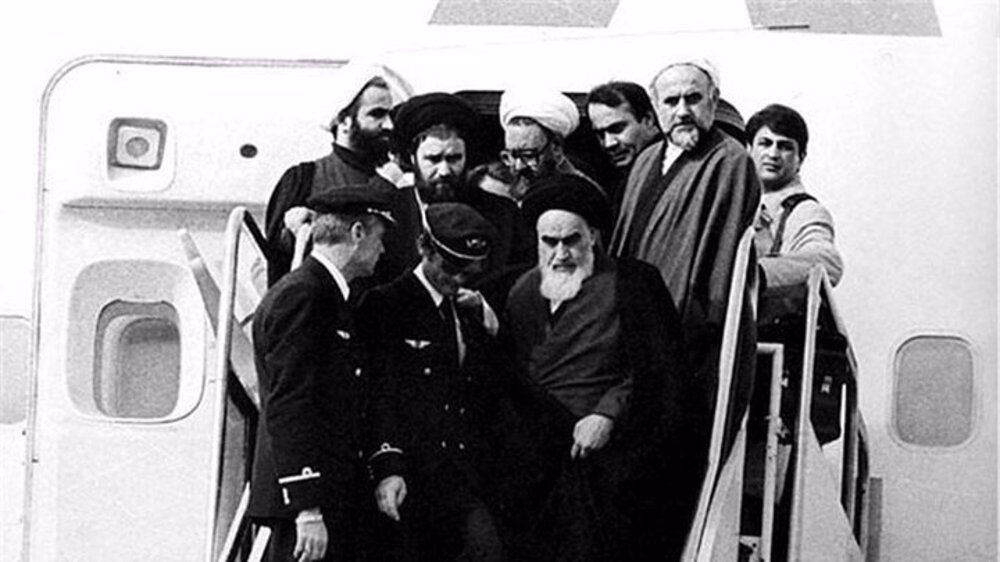
Iranians have started Ten-Day Dawn ceremonies across the country, marking the 45th anniversary of the 1979 Islamic Revolution, which put an end to the ruling of the US-backed Pahlavi regime in Iran.
The annual nationwide celebration started all over Iran on Thursday, symbolically marking the date of the homecoming of the late founder of the Islamic Republic, Imam Khomeini. Imam arrived back home from exile at 9:27 a.m. local time on February 1, 1979.
Imam spent more than 14 years in exile, mostly in the Iraqi holy city of Najaf. He also spent some time in Turkey and France before returning to Iran.
Millions of people converged on the capital from across the country on the day of his return.
His arrival gave considerable momentum to popular protests against the US-backed Pahlavi regime, which eventually led to its overthrow ten days later.
During the Fajr celebrations, Iranians take part in different events and activities to mark the occasion.
The festivities will culminate in nationwide rallies on February 11 this year, the anniversary of the Islamic Revolution.
Imam Khomeini’s arrival intensified months of popular protests against the Pahlavi regime. On February 8, 1979, a group of commanders, pilots, and staff of the Air Forces (Homafaran) went to Imam Khomeini’s home and expressed their loyalty to the revolution.
On February 11, 1979, the commanders of the armed forces attended Imam Khomeini’s home and submitted their resignation, declaring support to the founder of the Islamic Revolution. After the armed forces declared neutrality, the Shah regime’s main institutions and all other remnants collapsed.
Following the developments, Shapour Bakhtiar quickly fled Iran for France. These influential events marked the end of 2500 years of monarchy in the country. Imam Khomeini called on the people to restore peace and order.
The Islamic Revolution established a new political system; a republic based on Islamic values and democracy.
The beginning of the Fajr period is usually marked by the Leader’s visit to Imam Khomeini's shrine.
On Wednesday, Leader of the Islamic Revolution Ayatollah Seyyed Ali Khamenei paid tribute to Imam Khomeini at the Imam’s mausoleum in Tehran.
He paid respect at the burial ground of martyrs who lost their lives during the popular uprising that led to the revolution.
The Leader then paid his respects to the Iranian martyrs who lost their lives in terrorist operations by the anti-Iran and anti-revolutionary Mujahedin-e Khalq Organization (MKO) and Iraq’s 1980-88 imposed war on the Islamic Republic as well as other martyrs.
The Leader also paid homage to the grave of martyr Mohammad Amin Samadi, who was recently assassinated during an Israeli strike on Syria, and several other martyrs who helped defeat Daesh during Iran’s fight against the terror group in recent years.
Similarly, Iran's President Ebrahim Raeisi and his cabinet ministers visited the mausoleum and the cemetery.
The Iranian chief executive renewed his allegiance with Imam Khomeini’s ideals and the martyrs.
During the 10-Day Dawn celebrations, Iranians take part in different events and activities to mark the occasion.
On the eve of the Fajr celebration, Ayatollah Khamenei earlier visited the exhibition, held at the Imam Khomeini Hussainiya in Tehran on Monday morning.
Domestic products, especially those developed in knowledge-based companies and production supply chains, were featured in the exhibition.
The booth of knowledge-based companies in the field of mining and mineral industries, that the leader visited, displayed huge mining machinery and drilling equipment produced for the first time in the country.
The other booth that the leader visited was the booth of knowledge-based companies in the field of manufacturing electric motors for cars and optimizing energy consumption.
President Raisi also on Thursday participated in the inauguration ceremony of stagnant industrial and production centers in Hormozgan province.
The president hailed the act as a significant "benefit" for the nation, saying that 7,000 stagnant and semi-closed factories in Hormozgan province have been revitalized.
According to the president, the province ranks first in the movement of revitalizing closed factories.





Leave a Reply